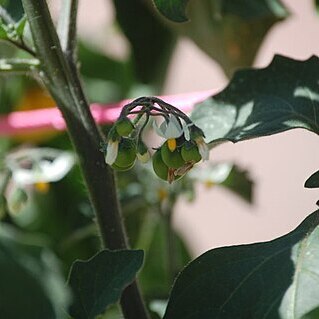Spreading, rounded, annual herb, bright green, up to 0.5 m high, 1 m in diam., pubescent, hairs simple, eglandular. Stems angular or ± winged. Leaves ± ovate or rhomboid, up to 80 x 50 mm, incised up to 5 pairs of triangular lobes, margins sinuate-dentate, bases tapering onto petiole, ± discolorous; petioles ± winged, up to 40 mm long. Inflorescence simple, umbellate cymes, 3-6-flowered, fruiting peduncles erect, up to 13 mm long; pedicels deflexed, 4-6 mm long. Calyx 2-5 mm long, lobes triangular, ± 1 mm long, reflexed in fruit. Corolla stellate, 9-12 mm in diam., white. Flowering time mainly Dec.-Apr. Fruit globose, 6-9 mm in diam., dull purple-black, opaque. Seeds many, up to 2 mm long, light brown or purple.
Leaves solitary or sometimes paired; petiole 0.4–5.6 cm long, ± narrowly winged, mostly distally; lamina herbaceous, 1.2–11.7 × 0.7–7.9 cm, elliptic to ovate-lanceolate or ovate, base truncate or rounded to cuneate and oblique, ± decurrent into the petiole, apex obtuse or acute, ± acuminate, ± deeply lobed, the lobes often well developed, obliquely triangular, obtuse or acute, or even semi-circular, spreading or antrorsely directed, ciliolate, both surfaces ± pubescent with more numerous hairs along the veins and towards the base mostly beneath, glabrescent.
Spreading, rounded annual herb, bright green, pubescent with simple hairs; prickles absent. Leaves ovate to ovate-lanceolate, the lamina 4–8 cm long, 2–5 cm wide, slightly discolorous, lobed; petiole to 4 cm long. Inflorescence short, 3–6–flowered; peduncle to 13 mm long; pedicels 4–6 mm long. Calyx 2–5.5 mm long; lobes triangular, 1–1.5 mm long. Corolla stellate, 12–14 mm diam., white. Anthers 1.5 mm long. Berry globular, 6–9 mm diam., occasionally smaller, dull black. Seeds 1.8–2 mm long, light brownish-yellow or purple.
Erect, branched, ± pubescent annual, up to 0.9 m tall. Leaves lanceolate to elliptical, up to 100 mm long, with winged petiole and truncate base, margins prominently uneven to serrate. Flowers few, umbellate, ± drooping, 9-12 mm diam., cream or white, each petal with a purple central stripe outside, sepals reflexed in fruit. Ripe berries dull, dark purple, globose, 9 mm diam., held in drooping clusters from outspread peduncles, edible (as jam).
A spreading annual herb. It grows 50-100 cm high. The stems are angled and grooved. The leaves simple and alternate and can have lobes or teeth. There are spreading hairs on the stems. The flowers are in small groups and are drooping. They are in the axils of leaves. The flowers are white, star shaped and 16 mm across. The fruit are green but turn black and 8 mm across. There are many seeds.
Annual herb, up to 0.9 m high; straggling. Spines absent. Leaves petiolate; blade decurrent, ovate to narrowly ovate, ± 50 x 20 mm, margins prominently lobed, indumentum short, unbranched hairs. Flowers: in a few-flowered, drooping umbel; corolla 12-15 mm in diameter, white; Oct.-May. Fruit a black berry, ± 8 mm in diameter.
Cymes lateral, unbranched, ± umbelliform, 3–6(7)-flowered; peduncle 0.3–2.5 cm long, slender, ± pubescent, erect or ascending, in fruit elongated to 3.4 cm, stiff; pedicels 3–7 mm long, slender, ± pubescent, decurved, in fruit elongated to 11 mm, deflexed.
Ovary c. 1 mm in diameter, depressed-globose to ellipsoid, glabrous; style 1.5–4.5 mm long, sometimes sigmoidal to the apex, with spreading, short hairs on the lower one–two-thirds, the stigma below the tip of the anthers or protruding by up to 1.7 mm.
Corolla white to creamy-yellow, generally with a longitudinal purple stripe in the centre of each lobe outside, 4.5–6 mm across, stelliform; lobes 1.5–3.5 × 0.7–2.2 mm, oblong or ovate to narrowly triangular, obtuse or acute, puberulous outside.
Calyx 1–2.5 mm long, campanulate, in fruit elongated to 3 mm; lobes 0.2–1.2 × 0.2–1 mm, semi-elliptic to narrowly triangular, obtuse or acute, ± pubescent, in fruit enlarged to 2 × 2.2 mm, ± spreading-recurved to strongly reflexed.
Erect, later spreading, annual herb, sometimes appearing bushy, 20–100 cm high and up to 100 cm across, ± pubescent with simple, straight or curved, usually appressed, eglandular, rarely glandular, short hairs, glabrescent.
Herb, up to 500 mm tall, unarmed. Leaves shallowly but distinctly lobed, with short simple hairs. Inflorescence a small umbel. Corolla 12-15 mm in diameter. Berries black. Flowers white.
Annual herb, up to 0.6 m high, not spiny. Leaves weakly and irregularly toothed. Flowers in few-flowered axillary cymes. Corolla 6 mm in diameter. Berries black or orange. Flowers white.
Branches ± angular to narrowly winged, the edges smooth or with ± spaced, soft, short teeth or prickle-like hairs, becoming subterete with age.
Fruits dull, black or purplish-black, opaque, 6–8 mm in diameter, globose or slightly depressed-globose, with sclerotic granules, poisonous.
Like S. nigrum but leaves deeply serrate, to 8 cm long, flowers 3-7 in clusters, white with purple keels, to 6 mm diam.
Seeds light brownish-yellow or flushed with purple, 1.3–2 × 1–1.7 mm, ± ovate in outline, pitted all over.
Stamen filaments 0.3–1 mm long; anthers 1.3–2 mm long, oblong.

